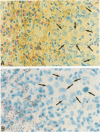Abstract
Transforming growth factor-beta 1 (TGF-beta 1) is a multifunctional cytokine which promotes fibroblast growth and collagen synthesis, but suppresses growth and differentiation of immune lymphocytes and killer cells. Immunohistochemical detection of TGF-beta 1 in Hodgkin's disease (HD) has been shown to correlate with the histologic feature of nodular sclerosis, which is associated with a favorable prognosis (American Journal of Pathology 1990, 136:1209). In that study, TGF-beta 1 was localized mainly at the margins of broad collagen bands (presumably sites of new collagen synthesis) and in areas containing numerous Hodgkin/Reed-Sternberg cells (H/RS). In these areas, TGF-beta 1 protein was found on the membrane and occasionally within the cytoplasm of H/RS cells. To determine whether TGF-beta 1 is synthesized by H/RS cells or secondarily bound to their membrane and sometimes internalized, we performed in situ hybridization (ISH) using 1.5 Kb 35S-labeled anti-sense and sense RNA probes to TGF-beta 1. Paraffin-embedded tissues of 10 cases from all histologic types of HD were examined. Somewhat unexpectedly, the major site of TGF-beta 1 mRNA was in eosinophils; TGF-beta 1 mRNA was not detected in H/RS cells. TGF-beta 1 mRNA was found in eosinophils in all cases of nodular sclerosis but not in other types of HD, despite the presence of numerous eosinophils in mixed cellularity cases. The presence of TGF-beta 1 mRNA coincided with immunohistochemical detection of TGF-beta 1 protein using antibody CC (1-30). These results confirm the role of TGF-beta 1 in the histogenesis of nodular sclerosing HD and indicate that eosinophils are the major source of TGF-beta 1 in this type of HD.
Full text
PDF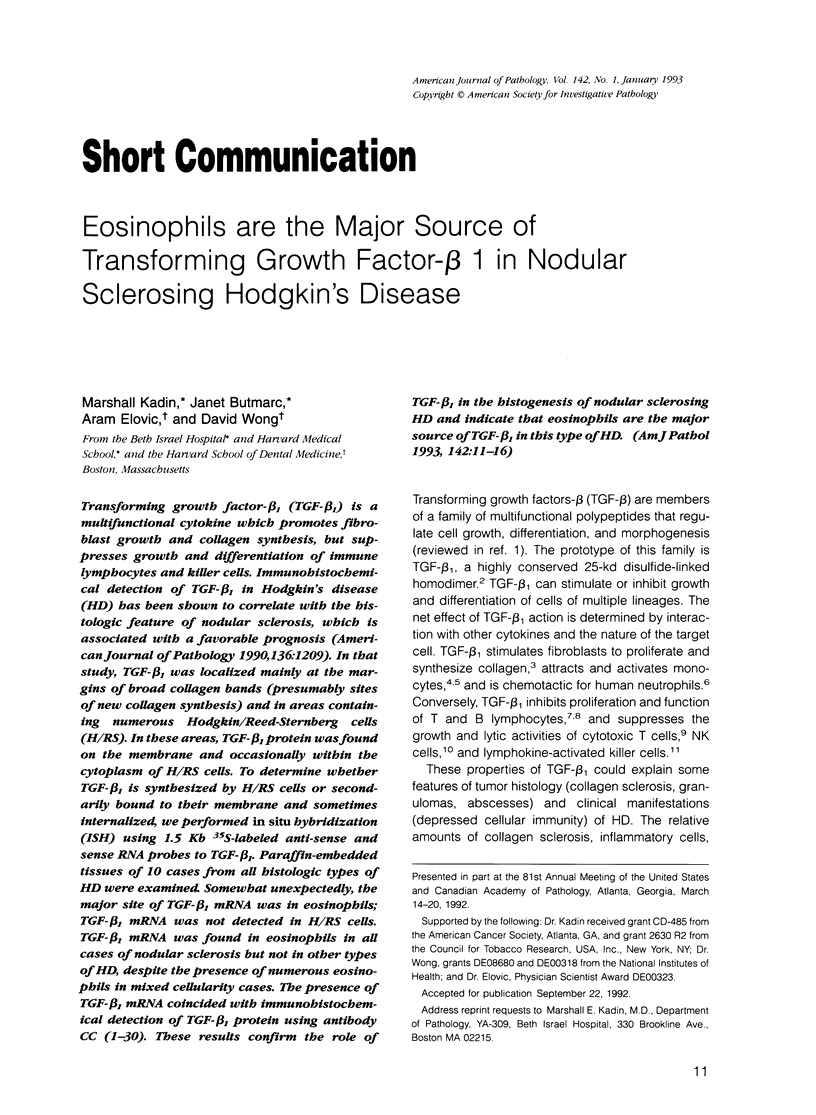

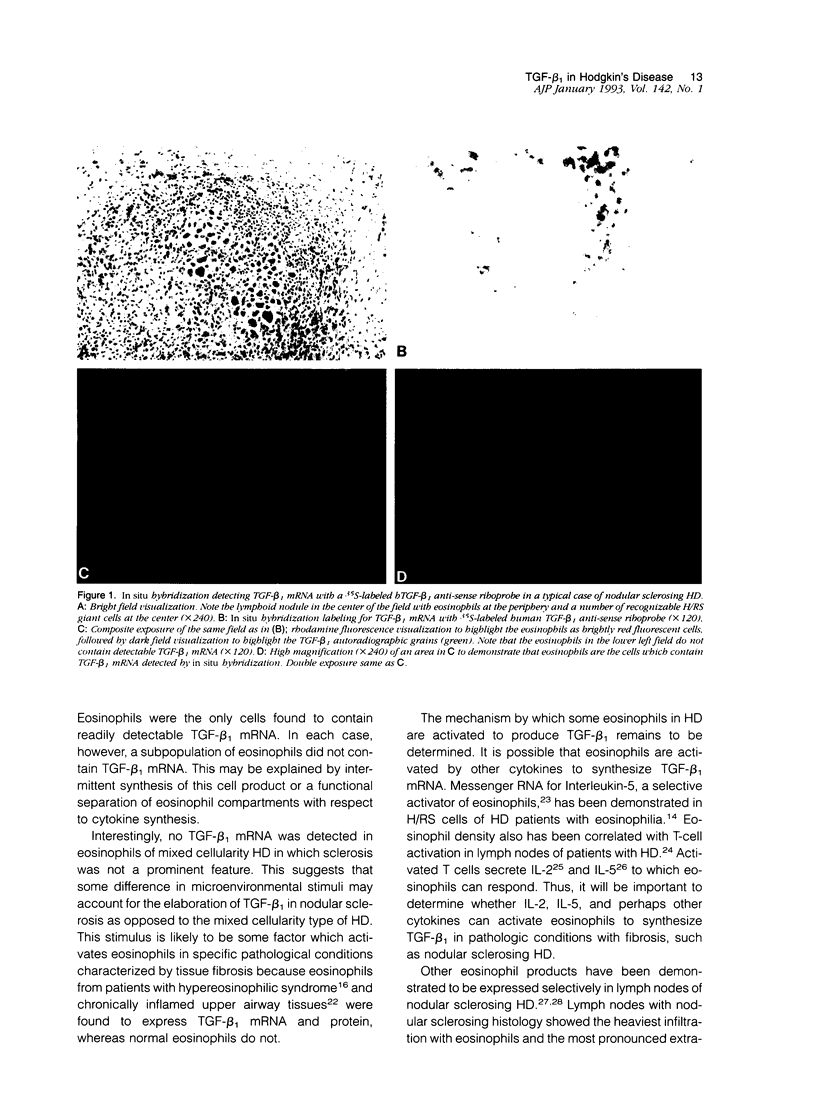
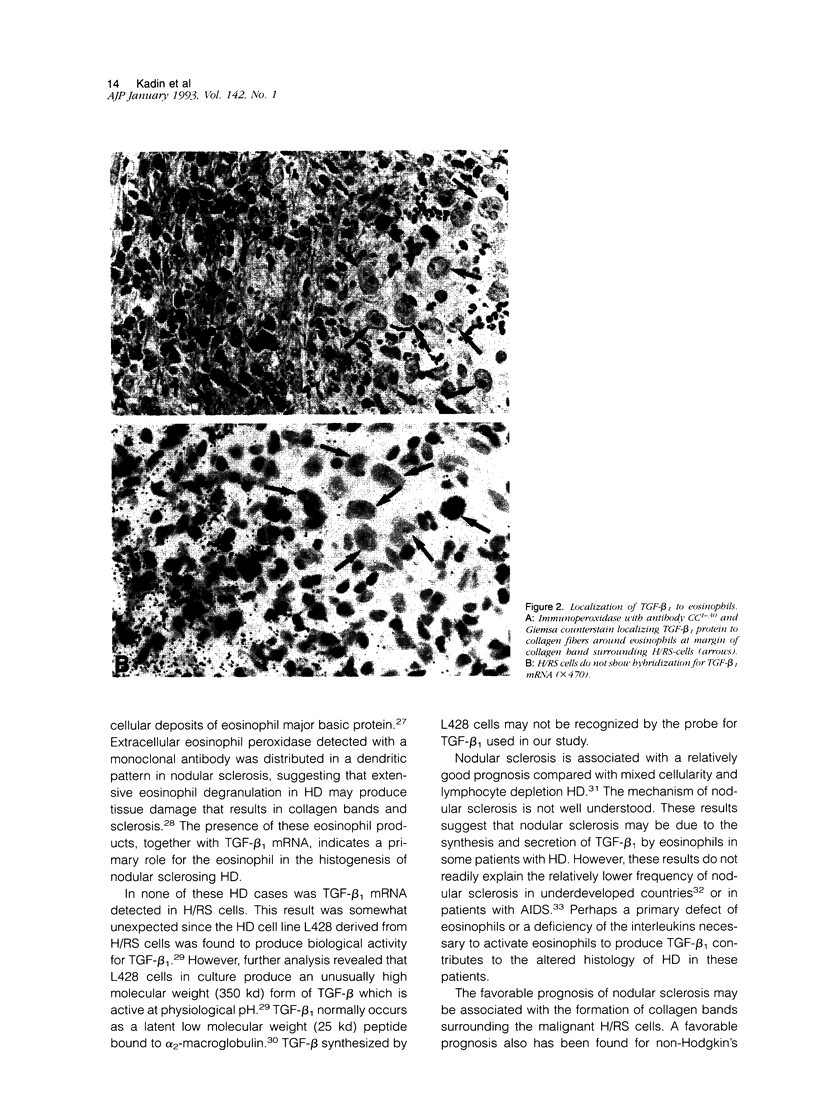
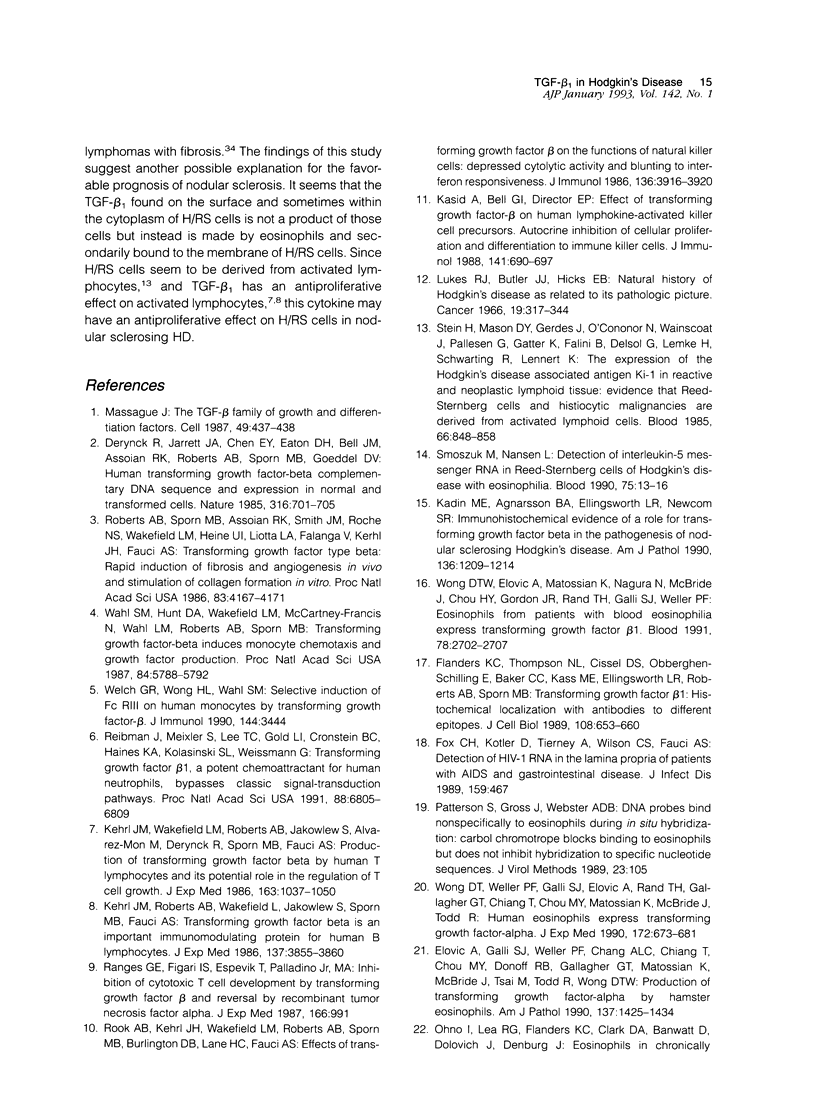
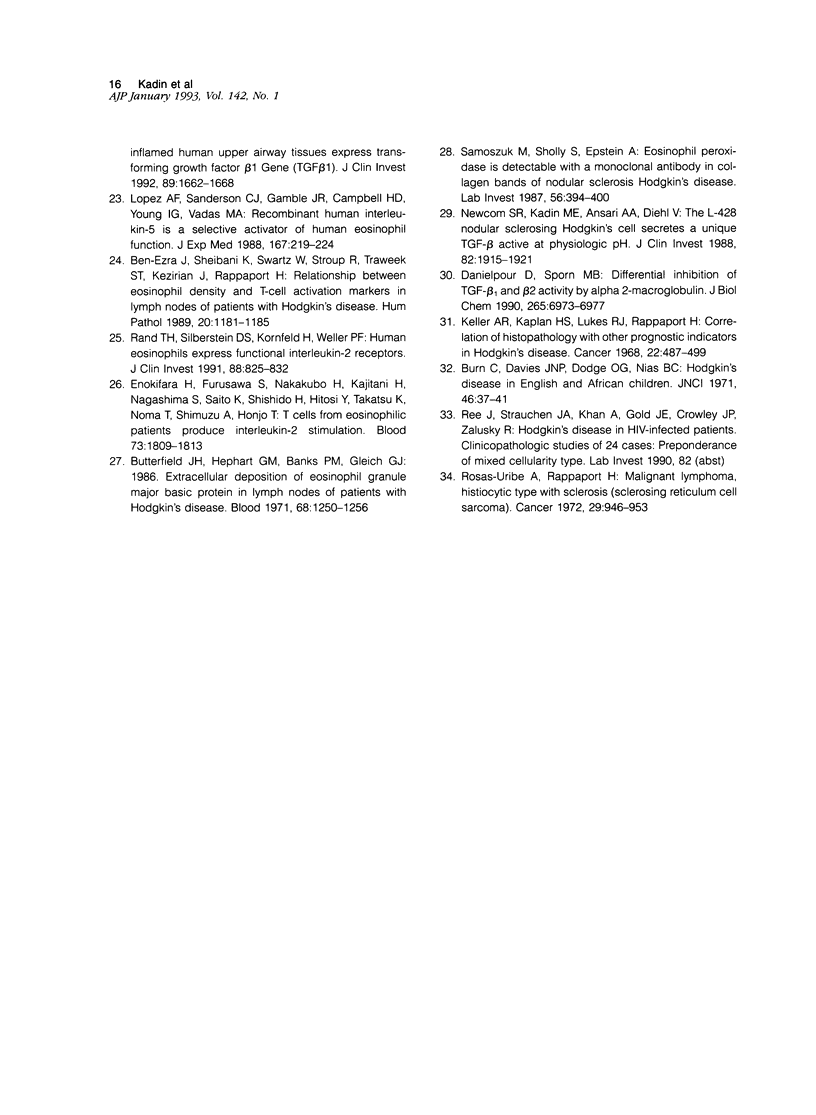
Images in this article
Selected References
These references are in PubMed. This may not be the complete list of references from this article.
- Ben-Ezra J., Sheibani K., Swartz W., Stroup R., Traweek S. T., Kezirian J., Rappaport H. Relationship between eosinophil density and T-cell activation markers in lymph nodes of patients with Hodgkin's disease. Hum Pathol. 1989 Dec;20(12):1181–1185. doi: 10.1016/s0046-8177(89)80009-7. [DOI] [PubMed] [Google Scholar]
- Burn C., Davies J. N., Dodge O. G., Nias B. C. Hodgkin's disease in English and African children. J Natl Cancer Inst. 1971 Jan;46(1):37–41. [PubMed] [Google Scholar]
- Butterfield J. H., Kephart G. M., Banks P. M., Gleich G. J. Extracellular deposition of eosinophil granule major basic protein in lymph nodes of patients with Hodgkin's disease. Blood. 1986 Dec;68(6):1250–1256. [PubMed] [Google Scholar]
- Danielpour D., Sporn M. B. Differential inhibition of transforming growth factor beta 1 and beta 2 activity by alpha 2-macroglobulin. J Biol Chem. 1990 Apr 25;265(12):6973–6977. [PubMed] [Google Scholar]
- Derynck R., Jarrett J. A., Chen E. Y., Eaton D. H., Bell J. R., Assoian R. K., Roberts A. B., Sporn M. B., Goeddel D. V. Human transforming growth factor-beta complementary DNA sequence and expression in normal and transformed cells. Nature. 1985 Aug 22;316(6030):701–705. doi: 10.1038/316701a0. [DOI] [PubMed] [Google Scholar]
- Elovic A., Galli S. J., Weller P. F., Chang A. L., Chiang T., Chou M. Y., Donoff R. B., Gallagher G. T., Matossian K., McBride J. Production of transforming growth factor alpha by hamster eosinophils. Am J Pathol. 1990 Dec;137(6):1425–1434. [PMC free article] [PubMed] [Google Scholar]
- Enokihara H., Furusawa S., Nakakubo H., Kajitani H., Nagashima S., Saito K., Shishido H., Hitoshi Y., Takatsu K., Noma T. T cells from eosinophilic patients produce interleukin-5 with interleukin-2 stimulation. Blood. 1989 May 15;73(7):1809–1813. [PubMed] [Google Scholar]
- Flanders K. C., Thompson N. L., Cissel D. S., Van Obberghen-Schilling E., Baker C. C., Kass M. E., Ellingsworth L. R., Roberts A. B., Sporn M. B. Transforming growth factor-beta 1: histochemical localization with antibodies to different epitopes. J Cell Biol. 1989 Feb;108(2):653–660. doi: 10.1083/jcb.108.2.653. [DOI] [PMC free article] [PubMed] [Google Scholar]
- Fox C. H., Kotler D., Tierney A., Wilson C. S., Fauci A. S. Detection of HIV-1 RNA in the lamina propria of patients with AIDS and gastrointestinal disease. J Infect Dis. 1989 Mar;159(3):467–471. doi: 10.1093/infdis/159.3.467. [DOI] [PubMed] [Google Scholar]
- Kadin M. E., Agnarsson B. A., Ellingsworth L. R., Newcom S. R. Immunohistochemical evidence of a role for transforming growth factor beta in the pathogenesis of nodular sclerosing Hodgkin's disease. Am J Pathol. 1990 Jun;136(6):1209–1214. [PMC free article] [PubMed] [Google Scholar]
- Kasid A., Bell G. I., Director E. P. Effects of transforming growth factor-beta on human lymphokine-activated killer cell precursors. Autocrine inhibition of cellular proliferation and differentiation to immune killer cells. J Immunol. 1988 Jul 15;141(2):690–698. [PubMed] [Google Scholar]
- Kehrl J. H., Roberts A. B., Wakefield L. M., Jakowlew S., Sporn M. B., Fauci A. S. Transforming growth factor beta is an important immunomodulatory protein for human B lymphocytes. J Immunol. 1986 Dec 15;137(12):3855–3860. [PubMed] [Google Scholar]
- Kehrl J. H., Wakefield L. M., Roberts A. B., Jakowlew S., Alvarez-Mon M., Derynck R., Sporn M. B., Fauci A. S. Production of transforming growth factor beta by human T lymphocytes and its potential role in the regulation of T cell growth. J Exp Med. 1986 May 1;163(5):1037–1050. doi: 10.1084/jem.163.5.1037. [DOI] [PMC free article] [PubMed] [Google Scholar]
- Keller A. R., Kaplan H. S., Lukes R. J., Rappaport H. Correlation of histopathology with other prognostic indicators in Hodgkin's disease. Cancer. 1968 Sep;22(3):487–499. doi: 10.1002/1097-0142(196809)22:3<487::aid-cncr2820220302>3.0.co;2-f. [DOI] [PubMed] [Google Scholar]
- Lopez A. F., Sanderson C. J., Gamble J. R., Campbell H. D., Young I. G., Vadas M. A. Recombinant human interleukin 5 is a selective activator of human eosinophil function. J Exp Med. 1988 Jan 1;167(1):219–224. doi: 10.1084/jem.167.1.219. [DOI] [PMC free article] [PubMed] [Google Scholar]
- Massagué J. The TGF-beta family of growth and differentiation factors. Cell. 1987 May 22;49(4):437–438. doi: 10.1016/0092-8674(87)90443-0. [DOI] [PubMed] [Google Scholar]
- Newcom S. R., Kadin M. E., Ansari A. A., Diehl V. L-428 nodular sclerosing Hodgkin's cell secretes a unique transforming growth factor-beta active at physiologic pH. J Clin Invest. 1988 Dec;82(6):1915–1921. doi: 10.1172/JCI113810. [DOI] [PMC free article] [PubMed] [Google Scholar]
- Patterson S., Gross J., Webster A. D. DNA probes bind non-specifically to eosinophils during in situ hybridization: carbol chromotrope blocks binding to eosinophils but does not inhibit hybridization to specific nucleotide sequences. J Virol Methods. 1989 Feb;23(2):105–109. doi: 10.1016/0166-0934(89)90124-9. [DOI] [PubMed] [Google Scholar]
- Rand T. H., Silberstein D. S., Kornfeld H., Weller P. F. Human eosinophils express functional interleukin 2 receptors. J Clin Invest. 1991 Sep;88(3):825–832. doi: 10.1172/JCI115383. [DOI] [PMC free article] [PubMed] [Google Scholar]
- Ranges G. E., Figari I. S., Espevik T., Palladino M. A., Jr Inhibition of cytotoxic T cell development by transforming growth factor beta and reversal by recombinant tumor necrosis factor alpha. J Exp Med. 1987 Oct 1;166(4):991–998. doi: 10.1084/jem.166.4.991. [DOI] [PMC free article] [PubMed] [Google Scholar]
- Reibman J., Meixler S., Lee T. C., Gold L. I., Cronstein B. N., Haines K. A., Kolasinski S. L., Weissmann G. Transforming growth factor beta 1, a potent chemoattractant for human neutrophils, bypasses classic signal-transduction pathways. Proc Natl Acad Sci U S A. 1991 Aug 1;88(15):6805–6809. doi: 10.1073/pnas.88.15.6805. [DOI] [PMC free article] [PubMed] [Google Scholar]
- Roberts A. B., Sporn M. B., Assoian R. K., Smith J. M., Roche N. S., Wakefield L. M., Heine U. I., Liotta L. A., Falanga V., Kehrl J. H. Transforming growth factor type beta: rapid induction of fibrosis and angiogenesis in vivo and stimulation of collagen formation in vitro. Proc Natl Acad Sci U S A. 1986 Jun;83(12):4167–4171. doi: 10.1073/pnas.83.12.4167. [DOI] [PMC free article] [PubMed] [Google Scholar]
- Rook A. H., Kehrl J. H., Wakefield L. M., Roberts A. B., Sporn M. B., Burlington D. B., Lane H. C., Fauci A. S. Effects of transforming growth factor beta on the functions of natural killer cells: depressed cytolytic activity and blunting of interferon responsiveness. J Immunol. 1986 May 15;136(10):3916–3920. [PubMed] [Google Scholar]
- Rosas-Uribe A., Rappaport H. Malignant lymphoma, histiocytic type with sclerosis (sclerosing reticulum cell sarcoma). Cancer. 1972 Apr;29(4):946–953. doi: 10.1002/1097-0142(197204)29:4<946::aid-cncr2820290441>3.0.co;2-3. [DOI] [PubMed] [Google Scholar]
- Samoszuk M., Nansen L. Detection of interleukin-5 messenger RNA in Reed-Sternberg cells of Hodgkin's disease with eosinophilia. Blood. 1990 Jan 1;75(1):13–16. [PubMed] [Google Scholar]
- Samoszuk M., Sholly S., Epstein A. L. Eosinophil peroxidase is detectable with a monoclonal antibody in collagen bands of nodular sclerosis Hodgkin's disease. Lab Invest. 1987 Apr;56(4):394–400. [PubMed] [Google Scholar]
- Stein H., Mason D. Y., Gerdes J., O'Connor N., Wainscoat J., Pallesen G., Gatter K., Falini B., Delsol G., Lemke H. The expression of the Hodgkin's disease associated antigen Ki-1 in reactive and neoplastic lymphoid tissue: evidence that Reed-Sternberg cells and histiocytic malignancies are derived from activated lymphoid cells. Blood. 1985 Oct;66(4):848–858. [PubMed] [Google Scholar]
- Wahl S. M., Hunt D. A., Wakefield L. M., McCartney-Francis N., Wahl L. M., Roberts A. B., Sporn M. B. Transforming growth factor type beta induces monocyte chemotaxis and growth factor production. Proc Natl Acad Sci U S A. 1987 Aug;84(16):5788–5792. doi: 10.1073/pnas.84.16.5788. [DOI] [PMC free article] [PubMed] [Google Scholar]
- Welch G. R., Wong H. L., Wahl S. M. Selective induction of Fc gamma RIII on human monocytes by transforming growth factor-beta. J Immunol. 1990 May 1;144(9):3444–3448. [PubMed] [Google Scholar]
- Wong D. T., Elovic A., Matossian K., Nagura N., McBride J., Chou M. Y., Gordon J. R., Rand T. H., Galli S. J., Weller P. F. Eosinophils from patients with blood eosinophilia express transforming growth factor beta 1. Blood. 1991 Nov 15;78(10):2702–2707. [PubMed] [Google Scholar]
- Wong D. T., Weller P. F., Galli S. J., Elovic A., Rand T. H., Gallagher G. T., Chiang T., Chou M. Y., Matossian K., McBride J. Human eosinophils express transforming growth factor alpha. J Exp Med. 1990 Sep 1;172(3):673–681. doi: 10.1084/jem.172.3.673. [DOI] [PMC free article] [PubMed] [Google Scholar]




